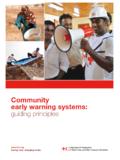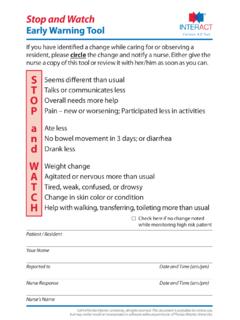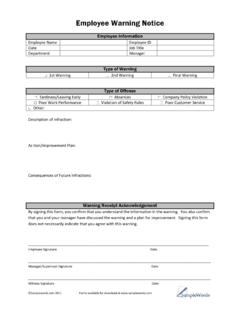Transcription of SUPERVISORY RISK ASSESSMENT AND EARLY WARNING …
1 BASEL COMMITTEE ON BANKING SUPERVISION WORKING PAPERS No. 4 December 2000 SUPERVISORY RISK ASSESSMENT AND EARLY WARNING SYSTEMS by Ranjana Sahajwala Paul Van den Bergh BANK FOR INTERNATIONAL SETTLEMENTS Basel, Switzerland BASEL COMMITTEE ON BANKING SUPERVISION WORKING PAPERS No. 4 December 2000 SUPERVISORY RISK ASSESSMENT AND EARLY WARNING SYSTEMS by Ranjana Sahajwala Paul Van den Bergh Abstract This paper is based on a study of a number of new bank monitoring systems currently in use or under development in various G10 countries.
2 Such systems are collectively termed SUPERVISORY risk ASSESSMENT and EARLY WARNING systems . The objective of the paper is to provide an overview of the different approaches taken by bank supervisors and to make a preliminary general ASSESSMENT of the methods that are being used or developed. The study reveals that SUPERVISORY authorities are now clearly moving towards putting in place more formal, structured and risk-focused procedures for ongoing banking supervision. Individual approaches and systems have been developed and adopted, typically in the 1990s, with a greater focus on risk profiles and risk management capabilities of individual banking institutions and on the generation of timely WARNING of potential changes to a bank s financial position.
3 These new and modified systems have contributed positively to the SUPERVISORY process, and supervisors are working towards refining the systems further in order to improve the systems' accuracy and predictive power. It is expected that in the future, formal risk ASSESSMENT and EARLY WARNING systems will continue to be developed and adopted by bank supervisors in developed and emerging market economies for risk-based supervision and will contribute significantly to strengthening the process of ongoing banking supervision. The Working Papers of the Basel Committee on Banking Supervision contain analysis carried out by experts of the Committee or its working groups.
4 They may also reflect work carried out by one or more member institutions or by its Secretariat. The subjects of the Working Papers are of topical interest to supervisors and are technical in character. The views expressed in the Working Papers are those of their authors and do not represent the official views of the Basel Committee, its member institutions or the BIS. Copies of publications are available from: Bank for International Settlements Information, Press & Library Services CH-4002 Basel, Switzerland Fax: +41 61 / 280 91 00 and +41 61 / 280 81 00 This publication is available on the BIS website ( ).
5 Bank for International Settlements 2000. All rights reserved. Brief excerpts may be reproduced or translated provided the source is stated. Contents Introduction .. 1 1. A simple framework for banking regulation and supervision .. 2 2. SUPERVISORY risk ASSESSMENT and EARLY WARNING systems .. 3 3. SUPERVISORY bank rating systems .. 7 Range of practices .. 7 Issues .. 12 4. Financial ratio and peer group analysis systems .. 13 Range of practices .. 14 Issues .. 17 5. Comprehensive bank risk ASSESSMENT systems.
6 18 Range of practices .. 18 Issues .. 21 6. Statistical models .. 22 Range of practices .. 23 (a) Models estimating ratings or rating downgrades .. 26 (b) Failure or survival prediction models .. 28 (c) Expected loss models .. 31 (d) Other models .. 33 Issues.
7 35 Conclusions .. 39 References .. 42 Annexes .. 45 1 Introduction1 Innovation, deregulation and globalisation in banking have contributed to making banking business more complex and potentially riskier. This has presented new challenges to bank supervisors with respect to the structuring of their ongoing supervision. In response, supervisors have developed new methods and processes for monitoring and assessing banks on an ongoing basis. Particular attention is being paid in this regard to improving the quality of bank examinations and to the development of systems that can assist supervisors and examiners in identifying changes, particularly deterioration, in banks financial condition as EARLY as possible.
8 Amongst the various new initiatives that have been taken or are being taken in this respect are the development of more formal, structured and quantified assessments not only of the financial performance of banks but also of the underlying risk profile and risk management capabilities of individual institutions. Collectively these various new approaches can be termed SUPERVISORY risk ASSESSMENT and EARLY WARNING systems . This paper is based on a study of a number of SUPERVISORY risk ASSESSMENT and EARLY WARNING systems currently in use or under development in various G10 countries as part of a move toward risk-based supervision.
9 The objective is to provide an overview of the different approaches taken by bank supervisors and to make a preliminary general ASSESSMENT of the methods that are being used or developed. Section 1 of the paper sets out a simple framework for banking regulation and supervision in order to describe where and how the new systems fit into the process of banking supervision. Section 2 categorises the different approaches that can be found in G10 SUPERVISORY practices with respect to risk ASSESSMENT and EARLY WARNING systems.
10 The various approaches, SUPERVISORY bank rating systems, financial ratio and peer group analysis systems, comprehensive bank risk ASSESSMENT systems and statistical models are subsequently described, compared and analysed in sections three to six, respectively. 1 Ranjana Sahajwala from the Reserve Bank of India was a visiting fellow at the BIS attached to the Secretariat of the Basel Committee on Banking Supervision and Paul Van den Bergh was Deputy Secretary General of the Basel Committee on Banking Supervision in 1999, when most of the background work was carried out.















